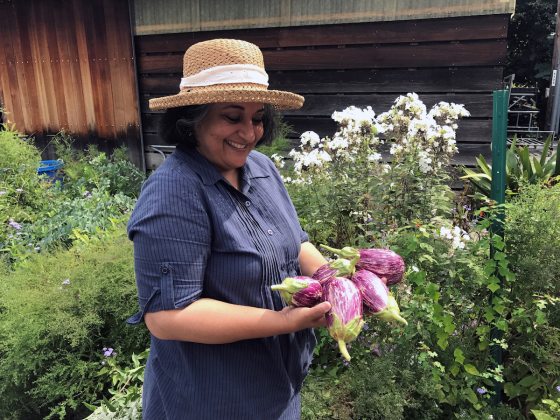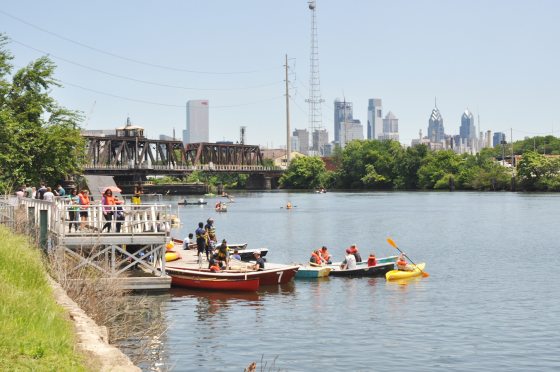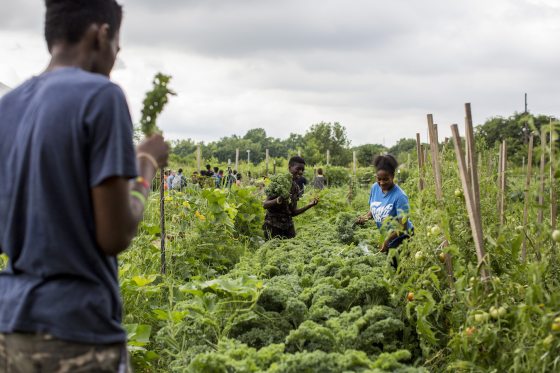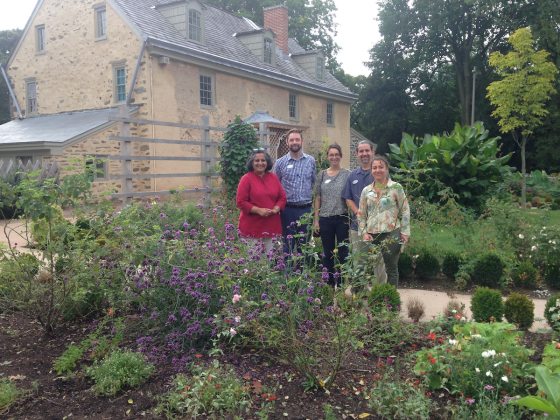In the early 1800s, at the country’s first botanic garden, Ann Bartram Carr welcomed boaters by serving them ice cream. Today, neighborhood kids ride Bartram’s Garden kayaks out to a raft on the Schuylkill River where they, too, are greeted with free ice cream.
Such is the spirit of welcome that we, the Longwood Fellows, were greeted with during our recent visit to Bartram’s Garden. The sweet fragrance of late summer roses, the vibrant colors of the fall meadows, the warmth of coffee on a cool morning, and engaging conversation were offered up to us in a “salon” session with Executive Director Maitreyi Roy. This is the second in a series of nine salons we will participate in this year with some of the region’s most courageous public horticulture leaders. Ms. Roy, who took the helm at Bartram’s in 2012, shared her enthusiasm for the beautiful garden and her team’s big idea with us: to use history to give shape to a dynamic present.

Bartram’s Garden Executive Director, Maitreyi Roy. Photo courtesy of Bartram’s Garden.
The Garden was originally created by the famed botanist and explorer, John Bartram (1699–1777). The estate where the garden is located was the base from which he worked and traveled, his family home, and a living preserve of plant species from much of the Eastern US and Canada. We recommend the book, The Brother Gardeners by Andrea Wulf, as well as a visit to the Garden, of course, for the amazing true tales of John Bartram.
In more recent times, Bartram’s Garden had been labeled a hidden gem, nestled in the woods in Southeast Philadelphia. Thanks to Ms. Roy and her team of “cultural travelers,”* the historic buildings and the 45 acres of gardens, woodlands, and meadows are now considered a community treasure. Bartram’s not only serves the local community, but has become a key player and an integral part of the fabric of that community. An important strategy has been to include the expanding diversity of community members in planning efforts and to obtain their constant feedback. The leadership at Bartram’s also engages with city visionaries who are planning a greener and more connected Philadelphia. As a result, the Garden has become both a hub for locals and a destination for visitors from around the city, region, and beyond. According to Ms. Roy, success is about experimentation, making mistakes, making discoveries, and building upon what works well for people, nature, and the community.
Ms. Roy summed up the primary goals of her team over the past five years at Bartram’s:
- Effectively sharing the history of the Garden and its creators: John Bartram, William Bartram, Ann Bartram Carr, and others. The legacy as reflected in the garden that grows today is as relevant now as it was at its founding. Being relevant is not intended to diminish history, says Ms. Roy, but to connect founding knowledge, stories, values, and ethics with new audiences.
- Building strong and meaningful connections with the local community. Bartram’s is a city park and community green space that is being preserved and maintained for all to enjoy as well as for education, growing food, and connecting with nature. Further, Bartram’s is intent on creating a vibrant civic commons by striving to be inclusive and a place where community dialogue can happen.
- Making a “hidden stretch” of riverfront an asset; restoring its ecology and showcasing the riverfront as an exciting landscape.

Saturday free boating on the Schuylkill River. Photo courtesy of Bartram’s Garden.
We also learned of the many programs and projects contributing to the fulfillment of the three goals. Programming ranges from historical and horticultural tours to community gardens and a food resource center at the Farm at Bartram’s. There are youth leadership development efforts, children’s programs, adult education, and volunteer programs. Major new developments include the construction of a riverfront biking/walking trail, called Bartram’s Mile, which will soon link up to other trails leading to and from City Center; the construction of a major freshwater mussel hatchery for water quality restoration; and the establishment of waterfront docks and boat storage for community use.

Bartram’s Community Farm and Food Resource Center powered by paid, local high school interns. Photo courtesy of Bartram’s Garden.
Partnerships are a key method for Bartram’s for leveraging available resources. Partners range from the City of Philadelphia, who owns the property; to the Schuylkill River Development Corporation, who partners with Bartram’s on the waterfront restoration and major development components; to small organizations such as Philadelphia Waterborne, who partners with Bartram’s on teaching math and science skills to local students via boat building.
Finally, it is important to note that great gardens like Bartram’s don’t happen without great leadership. From Ms. Roy, we learned that mission must drive the organization (not passing trends or external funder demands), and that the strategic plan must be the playbook. Changing to a more community driven model means changes in things like operations—later hours on evenings and weekends, adjusting programs and spaces to accommodate more people coming into the gardens, and getting creative and trying new things like community mussel farming and boating. Ms. Roy emphasized that to be an effective leader it is key to surround yourself with passionate people who have skills you don’t have. It is also about addressing “the little things that make people feel part of the garden, or not,” such as having helpful volunteers on hand to attend to the many community children who want to participate in river activities.
As we, the Longwood Fellows, continue on our journey of learning this year, we take with us these lessons from great leaders such as Maitreyi Roy and hope to seed them around! #FollowTheFellows

Bartram’s Garden Executive Director, Maitreyi Roy, with Longwood Fellows Patrick MacRae, Kaslin Daniels, Neil Gerlowski, and Julia Thomé. Photo by Tamara Fleming.
*Cultural travelers is a term describing people who leave their home environment behind, bringing only themselves and a desire to become part of the culture to which they travel.


